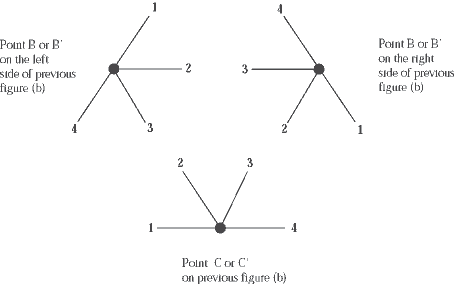HandsOn 30 - Random Walk on a Fractal
We now attempt to determine experimentally the average time it takes for a particle to move from one point to another on the Sierpinksi Gasket. The method is as follows: Roll a four-sided die, and move a random walker on the gasket. Keep count of how many steps the walker takes to move from one point to another point. By repeating this procedure, you will find the average time necessary to move specific distances.
Now
for the details. "Time'' in this case means the same thing
as the "total number of steps'' taken by the random walker.
If it makes it easier for you, call the unit of time 1 second, and
assume the walker takes 1 step per second. Then 10 steps take 10
seconds, 50 steps take 50 seconds, and so forth. The number of steps-the
time-to go from one point to another will most likely be different
for different trials because of the randomness of the process, based
on the flip of a coin or the throw of a die. Hence we will try to
predict the average times to go from one point to another.
To emphasize that the times are averages, we use brackets ![]()
![]() .
For example, the average time it takes to go from Point A
to Point B is written
.
For example, the average time it takes to go from Point A
to Point B is written ![]() TAB
TAB![]() .
.
In the following experiment we use a 4-sided die (available in some game stores) to produce random numbers. To use such a die, roll it and look at the number which appears along the bottom edge of the die. This is the result of your roll.
|
 |
To measure the average time it takes to go from one external vertex to another external point on the Sierpinski gasket (for example, from A to B' in Figure 8.2(a)), carry out the following steps. First, place your "walker'' (e.g., penny, pen top, thumb tack) at point A on the gasket. Flip a coin. If the coin comes up heads, move the walker down to the right. If the result is tails, move the walker down to the left. Now there are four possible directions for the next step. Roll the die. Move the walker according to the diagram in Figure 8.3. Select from the three possible orientations the one that fits your current position, and move the walker accordingly.
2. The goal of this second task is to evaluate the average time ![]() TAB''
TAB''![]() (= average
number of random steps) to move from Point A to either of the points
B'' in Figure 8.2(b). As
in Task 1, for each trial start the walker at Point A and record the
number of steps taken before arriving at either of the equivalent vertices
labeled B''. Also record the number of steps necessary to
first arrive at either point B' on each trial (this data can be used
to supplement your results in Task 1). Carry out 10 such trials recording
your results for each one on a data sheet.
(= average
number of random steps) to move from Point A to either of the points
B'' in Figure 8.2(b). As
in Task 1, for each trial start the walker at Point A and record the
number of steps taken before arriving at either of the equivalent vertices
labeled B''. Also record the number of steps necessary to
first arrive at either point B' on each trial (this data can be used
to supplement your results in Task 1). Carry out 10 such trials recording
your results for each one on a data sheet.
3. Now analyze your data. Because 10 is a small number of trials,
your average results may be very different from your neighbor's.
You can obtain better results by averaging the results of your
trials with those of the other members of the class.
|
|
|
Previous: 8.1 - Random Walk on a Fractal